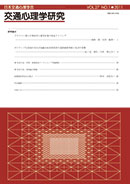Road traffic statistics for Japan indicate that the proportion of cyclists among the total accident fatalities has been increasing in the past decade. Elderly adults accounted for the majority of bicycle-related fatalities; therefore, we need to clarify the causes of their high accident risk. Previous studies have reported some cases in which judgments biased in a self-serving manner were related to intentions to engage in unsafe traffic behaviors. In this study, we measured the elderly cyclists’ gap acceptance and examined the influence of positively biased cognition on their crossing judgments. Participants were seated on bicycles and observed a car approaching from the right at 20 km/h or 30 km/h. They flashed an LED light at the critical timing when they could cross in front of the approaching car. Moreover, participants completed a questionnaire that measured the cognition about crossing. The distance between the approaching car and the participants was smaller for those who were likely to expect cars to yield and who were likely to underestimate their own accident probability. Consequently, educational intervention focusing on these psychological factors could reduce the number of accidents involving elderly cyclists.
抄録全体を表示
